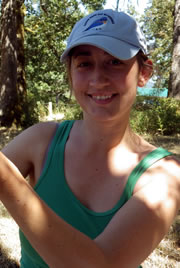Bring Back the Bluebirds Project: Season four in review
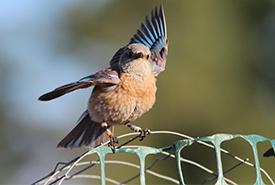
A female western bluebird steadies herself at a feeder before slipping through the robin-excluding mesh to grab mealworms for her second brood of fledglings. (Photo: R Hetschko/GOERT)
When, just days into spring, more adult western bluebirds had naturally returned to their former nesting or natal territories in the Cowichan Valley than in entire years previously, we knew we were in for a remarkable breeding season. But no one could have predicted just how remarkable and challenging, and unusual, and hopeful the fourth season of Vancouver Island’s western bluebird reintroduction project would be.
Within the first week of field work, 18 returned bluebirds (birds summering at the location, migrating south, and returning to the property in the spring) had been identified. This marked more returns than any previous year of the project (there had been eight returns in 2014).
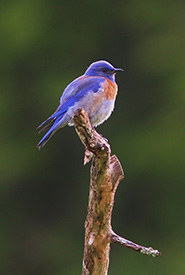
Fourth-year male, Cody, rests on a branch at NCC's Cowichan Garry Oak Preserve. (Photo by R Hetschko/GOERT)
One highlight involved the infamous "Cody," translocated in 2012 as a nestling and our oldest bluebird in the population. Cody, along with three other bluebirds that returned to Nature Conservancy of Canada's (NCC’s) Cowichan Garry Oak Preserve, made quite an impression at the In Bloom Wildflower Festival in May. These four birds made a show of peeking in and out of nestboxes and foraging from ancient oaks as visitors looked on in wonder and admiration. We were able to share in the moment of many first bluebird sightings, as several generations have been born not knowing that bluebirds once graced their beautiful Valley (“I can’t believe just how blue they are!”).
By peak breeding season in June, an additional five bluebirds were known to have rejoined the population. As it turned out, this big jump in return rate was more beneficial for the project than it would have been in any other year. A key component in our species recovery effort is the translocation of breeding pairs. In ecology, translocation is the deliberate capture, transport, and release of a species from one area to another and is a valuable tool to conservation biology.
As western bluebirds had not naturally dispersed back to their historic Vancouver Island habitat when nestboxes were installed, re-introduction was facilitated by capturing bluebirds from the closest healthy population in southern Washington and then releasing them in the Cowichan Valley on Vancouver Island. However, due to avian influenza outbreaks in other species throughout the region, translocation permits were delayed, preventing six of nine planned translocations. At the time, this was a substantial blow to the project as our target number of translocated bluebirds for a sustainable population was determined to be 90 adults.
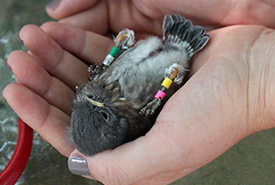
A two-week-old western bluebird nestling banded by the project technician. (Photo by R. Hetschko/GOERT)
Fortunately, this year the shortage of translocated bluebirds was offset by the many returning bluebirds, and the population was able to maintain its upward trajectory — so critical at this stage of recovery. Thus, in what could otherwise have been an unproductive breeding season due to fewer bluebird releases, an impressive 19 nests were attempted (the building of complete nests in nestboxes by bluebirds), with returned bluebirds attempting 15 of these nests and raising 52 of the 66 nestlings that fledged in the Cowichan Valley. This is a very positive sign for the project, as in 2014 only two of 12 bluebird nests built were by birds that had returned to the valley, while the rest had been attempted by newly released birds.
In conservation biology, no amount of experience and planning can compensate for the variability of environmental factors. This season, this particular western bluebird population was not only impacted by weather and disease, but it was also impacted by skewed sex ratios, predation and other natural causes of mortality. This year, as well as last year, more males returned to their natal territories than females (a common phenomenon with bluebirds).
This imbalance in the sex ratio was exacerbated by high breeding female mortality: over the course of the season, two females vanished, three females were found dead from unknown causes and one female was confirmed killed by a predator. Adding to the loss, five of six females left behind clutches of eggs that would go unhatched, and five of six mysterious deaths cannot inform future conservation measures.
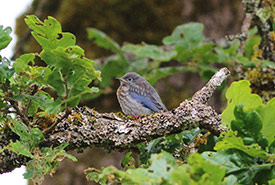
A juvenile western bluebird rests in a Garry oak tree just days after fledging. (Photo by R. Hetschko/GOERT)
In spite of these losses, a record number of bluebird juveniles fledged this year on Vancouver Island. And with so many active nests, there were bound to be at least as many successes as failures. Even "Cody," our oldest bluebird mentioned earlier in the article, was affected by the failures.
He had managed to find a mate this year after the loss of his mate of two seasons in 2014. Although this season’s mate was found deceased just days before her six nestlings fledged, Cody managed to raise all six juveniles to fledging on his own. We hope this super parent returns to NCC's Cowichan Garry Oak Preserve again next year to find another mate!
Much less unpredictable is the amount of public interest in this initiative to restore an iconic songbird to Vancouver Island, and in so doing replace a missing piece of the puzzle in endangered Garry oak ecosystems. For us, one of the best and recurring highlights of the season was the ability to share this project with others. Whether we were explaining the project to curious members of the public or helping others spot their very first western bluebird, it was a touching experience to spread this symbol of happiness and hope for conservation around the Island.
For these people, for the native cavity nesters that use our nestboxes, and for the recovery of an endangered ecosystem, we are working hard to re-establish a healthy population of western bluebirds in Canada’s Salish Sea region. We excitedly await the first bluebird returns of next spring, and we hope you do too. For updates, visit: http://www.goert.ca/activities/bluebirds/project-updates/.
Written by Jemma Green in collaboration with Reanna Shelling.

